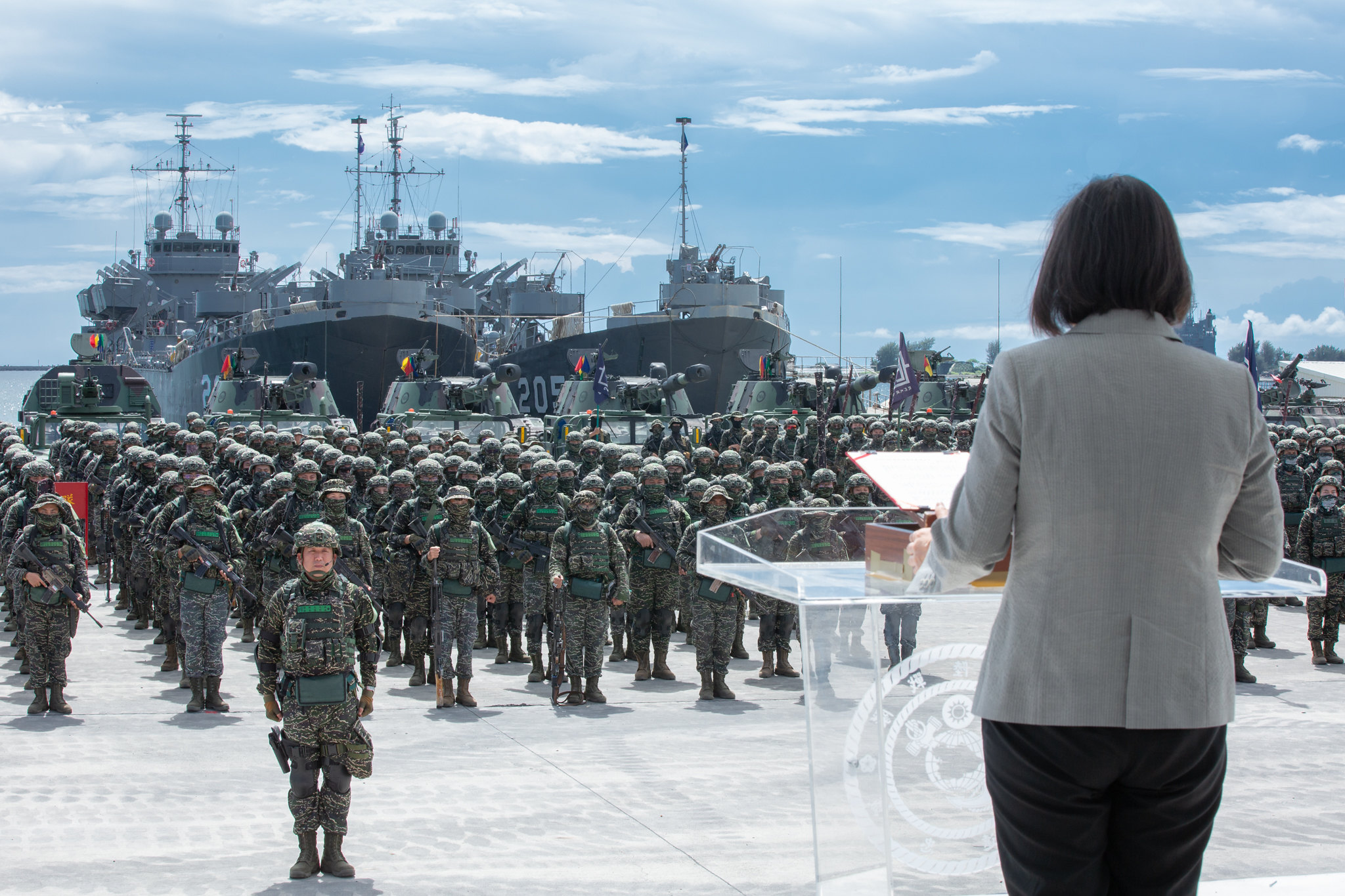Securing Taiwan Requires Immediate Unprecedented Cyber Action
The U.S. needs to act now to secure the technological dimensions of a looming Taiwan crisis, or risk losing far more than the island.

Published by The Lawfare Institute
in Cooperation With

The prospect of a Chinese invasion of Taiwan echoes some of the most disastrous 20th century instances of great power expansion—reminiscent, perhaps, of Nazi Germany’s Anschluss or even its subsequent invasion of Poland. Given that the latter ignited World War II, America’s strategic community has been rightly fixated on the vast military and political contingencies of a Chinese invasion that would remake Asia.
But Taiwan is not just the geopolitical fulcrum of the Indo-Pacific; it is also the nexus of a rapidly evolving Sino-American technological competition. And if 20th century great power competition is any guide, tech races are just as important to long-term competition as territorial military contests. The U.S. needs to act now to secure the technological dimensions of a looming Taiwan crisis, or risk losing far more than the island.
In the domain of Sino-American tech rivalry, Taiwan is unique in two aspects: First, the Taiwan Semiconductor Manufacturing Corporation (TSMC) remains the world’s tightest bottleneck in the global high-tech ecosystem, with exclusive capabilities to construct the most valuable, sophisticated computer chips in existence. Second, military conflagration in Taiwan would represent a hitherto-unknown level of cyber-intensive military conflict, the seeds of which likely have already been planted. Both of these realities demand unprecedented cooperation between the United States and Taiwan—cooperation that requires significant trust and openness in Taipei and significant counter-espionage and national security assistance from Washington.
The Silicon Brain Trust
It’s hard to overstate the importance of TSMC’s microscopic transistors: The company’s chips are the foundation of enormous sectors of national economic growth for both the U.S. and China. They are also the backbone of the massively consequential tech race between the two countries in security-essential sectors like artificial intelligence, quantum computing and advanced military capabilities. TSMC is estimated to have cornered as much as 90 percent market share of the world’s most advanced processors, and controls a majority of the global market for made-to-order chips. To stretch the historical analogy, it is as though a coterie of the world’s most accomplished nuclear physicists lived in a country that the Nazis aimed to annex in the 1930s, or like a collection of world-leading rocket scientists were on the verge of being absorbed into the Soviet bloc at the height of the Cold War.
It’s no coincidence that the world’s most precious technological capabilities are nestled in the world’s hottest geopolitical fault line. Taiwan’s government has long cultivated a “silicon shield” over the island in hopes that unique dominance in a crucial—but delicate—industry would deter China from rash actions against the island. In terms of imports, China spends more on semiconductors than on anything else—including oil—and in 2020, China’s semiconductor trade deficit stood at a whopping $233 billion. By intertwining Beijing’s long-term economic and strategic interests with Taiwanese semiconductors, the thought went, the PRC would be unlikely to invade the island because it would invite devastating supply-chain disruptions.
But that calculus may be changing. Stricter export controls on American-designed chips have stymied China’s access to advanced semiconductors from TSMC and elsewhere. The U.S. sanctions that cut off vital TSMC chips to Huawei, crippling many of the company’s prospects, seem ominous to many Chinese strategists. If Beijing’s decision-makers come to believe that something like Huawei’s fate awaits the PRC more broadly, Taiwan’s “silicon shield” will crack: Beijing would have nothing to lose, technologically speaking, from an invasion. If China could seize and leverage the personnel and facilities of TSMC effectively—or at least ensure they don’t continue accelerating U.S. technologies—it could have everything to gain.
Chinese efforts aside from an invasion have failed. Despite President Xi Jinping’s forceful statements on the immense value of semiconductor technologies for China’s security, little progress has been made in the mainland. China has already tried to recruit TSMC leaders to its own chip industry with limited success. Chinese hackers have been waging a chronic war on the company and have already stolen disturbingly large troves of information. But despite these efforts and the vast sums of money that China and other governments around the world are pouring into semiconductor alternatives, TSMC’s dominance in many of the most complex and competitive chip production techniques seems to only be growing. If China cannot buy, poach or steal TSMC’s talent, its next best option may be to conquer it—which is convenient enough, for a dictator who seems determined to reunify Taiwan with the PRC.
Ultra-sophisticated chips are a prerequisite for vast sectors of economic growth and are the key to a massively consequential tech race between the U.S. and China. Given those factors, the U.S. cannot afford to gamble on the fate of the world’s most advanced chipmakers. In light of the shifting incentives of Beijing, any American contingency plan for a Chinese invasion that does not coordinate with Taipei now on quickly securing the TSMC “brain trust” and their families in the event of a crisis is woefully incomplete. In the event of a successful Chinese invasion, and with proper planning, TSMC engineers and scientists have the potential to fulfill a similar role to that of the German Jewish refugees who were so central to the success of the Manhattan Project in the 1940s—if the U.S. can ensure their safety. On the other hand, their loss could set back global technological development by years, or supercharge China’s edge in advanced technologies.
Relatedly, U.S. counter-espionage efforts also need to focus on protecting the full design and production chain of advanced semiconductors around the world. Attempts to try to diversify TSMC’s geographic presence with new fabrication facilities (or “fabs”) in Arizona, Japan and possibly Germany are not without risks. Nor are the efforts to expand the capacity of alternative companies to compete with Taiwan’s dominance in the sector. Diversified expertise will ultimately mean more targets for one of the PRC’s most urgent intelligence objectives. Protecting such vital intellectual property will require similar procedures and approaches to those used in the construction of America’s most sensitive sites—like military bases, intelligence agency facilities and nuclear weapons depots. Outfitting new fabs with such precautions will be costly, but not nearly as costly as a major breach of techniques, designs or data to the PRC.
Cyberwarfare
Chip manufacturing is not the only technologically unique feature of a looming Taiwan crisis. Warfare writ large is at an inflection point, as emerging technologies subvert and transform conventional conflict, particularly between highly networked societies. In the coming decades, tensions between technologically advanced states are likely to manifest increasingly—and perhaps predominantly—in the cyber domain. Taiwan is also at the forefront of this world-altering trend: Never before have such technologically sophisticated states, with such highly networked communications, infrastructure and weapons, risked all-out war.
As the head of Taiwan’s Department of Cyber Security noted, Taiwan’s “critical infrastructure, such as gas, water and electricity are highly digitized,” meaning that the right cyberattack from China could prove catastrophic and leave the island in disarray. More than a few commentators have suggested that, in the event of an invasion, Beijing would very likely seek a fait accompli victory—a decisively rapid takeover of the island involving a debilitating cyberattack that would avoid a longer and more costly war with the U.S. Due to Taiwan’s level of networked sophistication and Beijing’s strategic imperatives, the unprecedented use of cyberwarfare in Taiwan is more likely than not.
But emerging cyberwarfare tactics differ markedly from conventional dynamics, not least in the degree to which they are covert and preemptive. Networks can be infiltrated silently and exploited months later in an explosive instant. And while the estimated 200-400 cyberattacks that Taiwan endures from China each month don’t constitute acts of war, even one successful attempt to worm into Taiwan’s networks could prove more destructive than any bomb if a military conflict were to kick off. Put simply, cyberwarfare would commence well before formal conflict.
Building on successful U.S.-Taiwan joint cyberwar exercises, the U.S. needs to work with Taipei to threat-hunt on Taiwanese networks as soon as possible. Cyberattacks do not necessarily constitute acts of war, so the U.S. aiding Taiwan’s defense in cyberspace most likely wouldn’t substantively risk upsetting today’s delicate political equilibrium in the Taiwan Strait, save perhaps further deterring Chinese aggression. It would, however, give the island-state a fighting chance against the legions of Chinese military hackers arrayed against it.
That aid would require direct U.S. access to Taiwanese servers, an unusual arrangement between sovereign states. Certainly Taipei could be forgiven for any hesitation about allowing such broad access, but China is likely already in these networks and bringing U.S. muscle to Taiwan’s cyber defenses could be the difference between crumbling under a Chinese offensive and maintaining robust defensive capabilities. Aside from bolstering commitments to Taiwan, the U.S. would also gain indispensable experience in navigating the cyber conflicts of the future, particularly one in which its primary geostrategic rival is the aggressor. The only alternative, trying to hunt down network vulnerabilities at the onset of conflict, would be far too little too late.
Contemporary Taiwan may be unique in the history of great power competition in the degree to which both geopolitical conquest and a superpower tech race are at stake. Each requires different, but interrelated, preparations on distinct timescales. Any strategy that fails to weigh the two together is not a winning one. And while no part of a Chinese invasion on Taiwan will be easy, the U.S.’s urgent technological priorities are, at least, clear—and ripe for immediate action.


.jpg?sfvrsn=8efcefb8_3)



